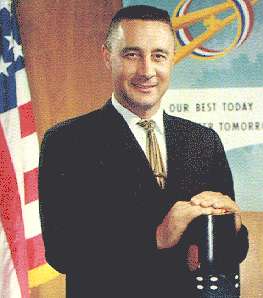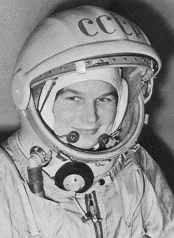

In order to learn about sending men into orbit, America had embarked on project Mercury. The small Mercury capsule was capable of taking one astronaut into orbit. Unlike the Russian Vostok spacecraft, the Mercury capsule could actually be steered in space and the astronauts could enjoy piloting the craft in space.
Alan Shepard had flown the first Mercury mission. It was now the turn of Gus Grissom to fly the second.
 Grissom's flight would be a duplicate of Shepard's. This flight would have its problems, not in space but on the ocean.
Grissom's flight would be a duplicate of Shepard's. This flight would have its problems, not in space but on the ocean.
Shortly after splashing down in the Pacific, the charges on the escape hatch blew and the hatch flew open. As the capsule pitched on the waves it quickly started to take on water and within seconds had disappeared, sinking to the ocean floor. Fortunately Grissom had been able to scramble out and was winched to safety.
 Sixteen days after Liberty 7 had sunk to the bottom of the Pacific, the Russians sent one of their huge SS-6 boosters skyward carrying Major Titov aboard the spaceship Vostok 2.
Sixteen days after Liberty 7 had sunk to the bottom of the Pacific, the Russians sent one of their huge SS-6 boosters skyward carrying Major Titov aboard the spaceship Vostok 2.
Titov stayed in orbit a full day. The Russian cosmonauts now had over 24 hours flying time in space, the American's about thirty minutes.
At this point in the American space program the Redstone boosters had served their purpose but the more powerful replacement, the Atlas was proving unreliable. Two out of every three launches ended up with the Atlas rocket exploding in flames. There was not a long queue of astronauts waiting to ride one into space.
However by September 1961 the engineers felt they had cracked the problems and in February 1962 John Glenn was the first astronaut to be fired into orbit by the new Atlas booster. Glenn also became the first American to complete a full orbit in space. The flight though didn't go to plan.
While Glenn was marvelling at the views of earth, a full scale emergency had developed at mission control. Sensors indicated the heat shield that would protect Glenn from frying in the 4000 degree re-entry burn up might have come loose. If it separated from the spacecraft then America's first orbitting astronaut would return as ashes.
If the sensors were correct, the only thing holding the heat shield in place were the retro rockets that would normally be jettisoned prior to re-entry. After considering many options mission control radiod Glenn to explain the situation and told him not to jettison the retro rockets. Nobody knew if this would save John Glenn's life or not.
After 4 hours and 43 minutes in flight, Glenn fired the retros and started his earthward plunge. As he struggled to keep the Mercury capsule under control he watched through the small window as the retro rockets broke up and parts of his burning craft crashed against the sides of the ship and hurtled into space.
For four minutes the ionized air around the capsule prevented communication between mission control and Glenn. For four minutes nobody on the ground knew if he had made it. Then John Glenn's voice came through and the controllers knew that their astronaut was coming home alive.
The next Mercury flights were less dramatic. Scott Carpenter replicated John Glenn's three orbits in space and Wally Schirra completed six orbits. By the time Gordon Cooper flew the last of the Mercury missions, his flight lasted a full 22 orbits.
On 16th November 1963 president Kennedy visited Cape Canaveral launch centre and saw for himself the pad that would one day launch the huge Saturn V rockets to the moon. Six days later Kennedy flew out to Dallas and during his visit was assasinated.
In June 1963 Russian cosmonaut Bykovsky remained in space for 119 hours. Before he landed the Russians sent the first female cosmonaut into space.

As the respective Mercury and Vostok projects ended, Russia still seemed to be ahead in the space race. However they were increasingly becoming reliant on headline making flights.
The Americans now moved on to project Gemini. The Gemini spacecraft would be used to plot their course to the moon.

 Page 3 |
 Page 5 |
